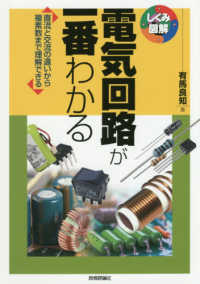- ホーム
- > 洋書
- > ドイツ書
- > Mathematics, Sciences & Technology
- > Biology
- > Ecology
Full Description
Meliponini, the stingless bees of the tropics, process and store honey, pollen and plant resins to maintain their colonies. The chemical components of their nests are bioactive and believed to be therapeutic for a long list of maladies. However, only recently are tests and analyses being done with molecular and modern laboratory techniques, such as high throughput EDX, HPIC, HPLC, GC, NMR, PCR, and ultrastructural SEM; coupled with diverse detectors such as DAD, RI, MS, SCD.
This two-volume book is about the cerumen -plant resins mixed with stingless bee wax- and propolis, which fortify the colony in ways that are beginning to be understood. It includes reviews and new research on diverse topics involving the chemistry and bioactivity of plant resins, cerumen, propolis, besides bee and microbe behavior and ecology. These analytic studies are presented along with stingless bee biodiversity, palynology, cultural knowledge, bee foraging behavior, resin flower evolution, ecology, and evolution of nest microbe mutualisms, social immunity, human health, the decisive role of microbiology investigation in moving forward, natural history of stingless bee colonies and nests, marketing, and bibliometrics for plant resin use by bees, propolis, and the Starmerella yeast.
Contents
Part I. Stingless bees, propolis and resinous plant biodiversity.- Chapter. 1. Economic feasibility and income security of stingless bee-keeping for small holder farmers in Southeast Asia.- Chapter. 2. The chemical diversity of stingless bee propolis and cerumen.- Chapter. 3. Global trends on plant resin use by stingless bees (1985-2022) and Apis mellifera (1967-2022) research: A bibliometric analysis.- Chapter. 4. Pollen assemblages of propolis from stingless bees in two Mexican regions.- Chapter. 5. Stingless bees of Peru: The use of plant resins, cerumen and propolis.- Chapter. 6. Stingless bees (1955-2021) and other bees (1945-2021) in propolis research. A bibliometric review of scholarly articles.- Part. II. Resins for the plant, the environment and the stingless bees.- Chapter. 7. Division of labor in stingless bee nests: Does each kind of propolis have a role?.- Chapter. 8. Production and application of propolis from fivestingless bee species in China.- Chapter. 9. The importance of plant community composition and diversity for resin collection and functioning.- Chapter. 10. Use of plant resins and social immunity in honey bees and stingless bees.- Chapter. 11. Use of resins for defense and nest building in stingless bees.- Chapter. 12. Plant resins - their role for plants and use by stingless bees.- Chapter. 13. The significance of palynological analysis of stingless bee products containing resins.- Chapter. 14. Notes on resins and other building sticky materials in the life of seven stingless bee species from the Chaco region, Argentina.- Chapter. 15. Where do stingless bees collect resins in the Neotropics?.- Chapter. 16. Etymology of 33 Neotropical stingless bee genera and 74 Melipona species in the tribe Meliponini Lepeletier, 1836 named in the period 1798-2012.- Chapter. 17. Pharmaceutical stingless bees.- Appendix. A.- Appendix. B.- Appendix. C.- Appendix. D.- Appendix. E.- Appendix. F.- Appendix. G.- Appendix. H.- Index.








